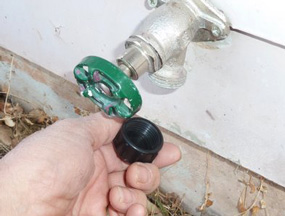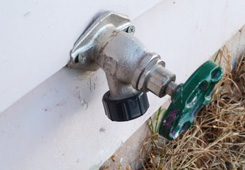 SURPRISE! So-called “freeze proof” water faucets will freeze and split internally if your customer has left their hose attached over the winter.
SURPRISE! So-called “freeze proof” water faucets will freeze and split internally if your customer has left their hose attached over the winter.
HOWEVER, this hidden internal rupture won’t be noticed until AFTER an unsuspecting cleaner (like you!) hooks his machine up and turns on the faucet. So while you are cleaning UPSTAIRS everything is being flooded DOWNSTAIRS!
Even though this is an “accident waiting to happen” we all know who gets the blame here! (Don’t ask me how I learned this one!) Sooo…
Be very cautious early in the spring with all outside faucets. But ESPECIALLY with an outside hose bib with a hose that’s been hooked up all winter!
So tweak your Spring time ‘hose hooking up’ procedures: 
1. Buy a female cap with a rubber hose washer inside that will thread on any faucet bib.
2. Tighten the cap on the hose bib, briefly turn on the faucet slightly and listen closely. (You can also keep your hand on the faucet to feel the vibration of running water.)
3. If you can hear (or feel) running water the faucet has an hidden, ‘internal rupture’ inside the wall!
4. Turn the faucet off immediately, inform the homeowner of THEIR problem and find your water supply elsewhere.
Steve’s Bone-headed Mistake: I did way too many ‘freebie water damage losses’ and replaced way too many hose faucets that the homeowner was just sure had “burst due to your cleaning pressure”!
Steve’s Painfully Learned Solution: Carefully test all water faucets with your .99 hose cap until home owners eventually discover their split faucets on their own! (Usually when watering their lawn.) After all, when your customer floods their own home it then becomes a PAID water loss for you!
Lost your hose cap? Then just kink your water hose closed when turning the faucet on and… LISTEN CAREFULLY!
Steve
NOTE: You may not have flooded the customer’s home … yet! But we’ve all accidentally created a horror story out on the job. So share your “tale of woe” in our Strategies for Success: Growing Your Business Facebook Group!
Simple little warnings like this one just might keep your business from plummeting to disaster. Now just imagine a new idea (or warning!) arriving every week! So if you’re not already signed up for these weekly QuickTIPS, do so now.

We had a water loss last week that was caused by a frost free faucet. We dried the structure and started the repairs. The flooring guy started laying tile and laid the first four hundred feet for the day and started cleaning his equipment when the home owner showed up and said that they still did not have the faucet fixed. The tile guys jaw dropped, said he was sorry and called me. When we started under the house to inspect what was wet we found 18 inches of water in the crawl space. Not just a corner or two the entire crawl space. We did the math set our pumps and pumped water for several hours and dried the structure again.
One of our Mytee portables started leaking on a clients hardwood floor on the middle level while the tech was upstairs cleaning the carpets. By the time the homeowner noticed it was running down a vent through the basement ceiling. The Mytee portables have a plastic filter which freezes easily. But sometimes this isn’t apparent until the crack expands after a few jobs. Unfortunately, the client wouldn’t allow us to rectify the water damage. She called ServiceMasher and we got the bill for $2,500 from a job we made $250.
Ouch, Tom! I feel your pain- really! Sorry to hear this.
Steve
PS At this point I can’t do much more than tell you what I do when disaster strikes. 1) Change our procedures so that THIS particular problem never happens again and 2) move on! (And I remind myself that damages are TAX DEDUCTIBLE!) 🙁
NOTE to Eric: Now a loss like that is what I call “double dipping”. I would say to warn homeowners to FIX the problem before letting contractors in. But that just might be “shooting yourself in the foot”!
Yes I did! – A water damage loss for free….
My solution was to invest in a BRASS water hose shut off valve and attached it to the end of my hose. I always turn on the water and listen first – before I open the valve.
It also is a bonus to turn off the valve before disconnecting the hose – I avoid a cold shower!
I’m previously a pressure washing contractor so my stories are mostly about pressure washing. We were washing a four story garage in Bellevue and letting the filtered water run down the drains as we had discussed with the building manager. What we didn’t know was the water was also draining into the electrical sub-station built at the base of the garage. It fed power to all the surrounding buildings. After we were done, there was an explosion when the water finally seeped into one of the high-voltage transformers. The next morning every city engineer, inspector, police officer, foreman was there waiting for us to show up.
Turns out the room was built wrong as it had no drain and was the lowest point in the structure. We weren’t held liable for the damage to the sub-station but we got sued by the 400 or so business that lost business during the power outage. Our insurance company just settled them all. It wasn’t our fault but wasn’t worth the fight.
Needless to say, we ALWAYS check to see where our water is going and keep it controlled.
My carpet cleaner was doing a job in a 2nd floor condo.
Thankfully we didn’t have a ruptured hose issue, but had a bad outcome nonetheless.
The first room went great, the floor and sofa cleaned beautifully looked like new and in the 2nd room, disaster struck!
Hot water was dripping from the quick connect brass fittings and burning my cleaner’s hand.
Instead of stopping to reconnect the fittings, or even grabbing one of the white towels we bring on every job, he pulled a blue rag from his pocket and wrapped it around the brass fittings.
Consequently, 250°+ hot water touching the blue cloth released blue dye in the fabric which dripped onto the condo owners tan bedroom and hallway carpet.
New carpet, paid for by our liability insurance provider cost $2,000 against a $250 cleaning job.
On a positive note we received a referral after the new carpet was installed because the condo owner was impressed with how to took responsibility and “fixed” the problem.
We have a listening stick! We cap off faucet than put rod on faucet and listen on every job. Just because it is spring does not mean that they don’t have a leak!